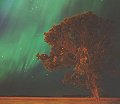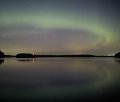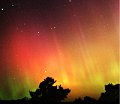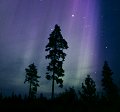
|
back to spaceweather.com |

|
|
Summary: Giant sunspot 69 hurled two coronal mass ejections toward the Sun in mid-August. One struck on August 15th, the next on August 18th. Both impacts triggered modest auroras. Geomagnetic activity intensified on August 20th when the interplanetary magnetic field near Earth turned south--a condition that favors Northern Lights. In all ... a week of auroras. |
| Photographer, Location | Images | Comments | |
|

|
Dominic
Cantin, l'ile d'Orléans, 30 km east of Québec City,
Canada Aug. 21 |
#1, #2, #3, #4, more | D. Cantin: "The nearly-full Moon added to the scene; it was beautiful to see this aurora over an illuminated wheat field! My wife said these were the most beautiful auroras that she had ever seen (but it was only her 2nd time seeing auroras)." Photo details: 28 mm @ f 2.8 , 25 sec, Fuji Superia 800 |
|

|
John
Russell, Nome, Alaska Aug. 19-20 |
#1, #2, #3, more | J. Russell: "Very nice activity on both nights (the 19th and 20th) with an amazing burst on the 20th in near-daylight." Photo details: Nikkor 28mm f1.4, and Superia 800, 4 to 8 seconds exposure. |
|

|
Warren
Justice, near Dauphin, Manitoba, Canada Aug. 19 |
#1, #2, #3, #4, #5, #6 | W. Justice: "These were not bright aurora but they were very active with alot of 'dancing around' especially overhead. I have included two overhead images. One looks like a shark or some sea creature and the other looks like a ghost." Photo details: 28mm f1.9 @ aprox. 12 sec. Film: Fuji Superia 800 X-tra. |
|

|
Tom
Eklund, Toijala, Finland Aug. 21 |
#1, #2, #3, #4, more | T. Eklund: "This was the best aurora that I have seen in 10 months and it had one of the best wave like pulsations that I have ever seen!" Photo details: F/2.0, 15 -30 sec and Fuji Provia 400F |
|

|
Vesa
Särkelä, Kemijärvi, Finland Aug. 20 |
#1, #2, #3, more | Photo details: 28 mm lens, 30-60 sec, Fuji sensia 100 |
|

|
Stephane
Levesque, Luceville, Quebec, Canada Aug. 21 |
#1, #2, #3, #4, #5, more | Photo details: 28mm, f3.5, 400asa, 30 seconds |
|

|
Dominic
Cantin, Valbélair, 15 km north of Quebec city, Canada Aug. 19 |
#1, #2, #3, #4, more | Photo details: 28 mm @ f 2.8, 25 sec, Fuji Superia 800 |
|
|
Brian
Larmay, Tichigan, Wisconsin, USA Aug. 20 |
#1, more | B. Larmay: "I took this picture just after sunset using Fuji 800 film and a 28mm lens" |
|

|
Stan
Richard, Minocqua, northern Wisconsin, USA Aug. 19 |
#1, #2, #3, more | S. Richard: "I was vacationing in the northwoods of Wisconsin on Aug. 19 when I awoke at 4:30am. to see these beautiful northern lights. The dawn was fast approaching so I had to shoot quickly. What you can't see or hear in the pics was the spooky ground fog and the a pair of owls echoing back to each other off in the distant woods, quite magical." |
|
|
Philippe
Moussette, Quebec, Canada Aug. 20 |
#1, more | Photo details: "Coolpix 995 digital camera, 30 sec. exposure at 400ASA" |
|

|
Einar
Jonskaas, Hamar, Norway Aug. 18 |
#1, #2, #3, #4 | Photo details: 28 mm lens, Kodak Gold Ultra 400, 12 sec. exposure |
|

|
Juha
Kinnunen, Jyväskylä, Finland Aug. 18 |
#1, #2, more | J. Kinnunen: "This pretty display was the season's first for me; the nights are getting just dark enough to witness aurora here. The dominating tone was violet, just like in late April, when I took my last images of the previous season." |